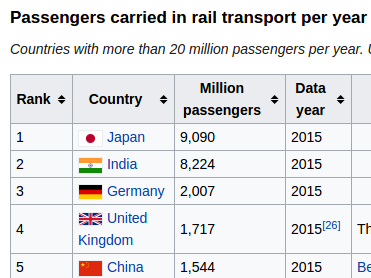Day 39 - 8 BILLION passengers are carried every year by the Indian Railway. WHOA!
28 Mar 2017 100daysofwritingOkay, I can feel this being a short post. It’s just that I am in the phase between two books where I haven’t committed to anything just yet. Emma (Austen) is waiting to be picked up. That book is in the public domain, and the people at Amazon are really nice to put it up on the Kindle store and save everyone the trouble of having to download it and copy it over to the Kindle!
An interesting thing that I discovered today was the total number of passengers that use the Indian Railway system each year. The number is HUGE. It’s HUGE, it’s like nothing I would have imagined. Before seeing the figures, I made a rough estimate of maybe half the population of India which is about 600 million.
The actual number was 8 BILLION passengers, per annum. Yeah, that’s 500 million more than the TOTAL POPULATION OF THE EARTH. It’s a NUMBER that I can barely even make sense of, 8 times the population of India! (That number is the number of passengers carried in rail transport in 1 year)
Surprisingly, two things come up here:
-
Japan has 9 BILLION PASSENGERS carried each year. HUH? The population of Japan is about 120 million. That’s 10 times less than India’s population. Also, the total area of India is about 9-10 times more than Japan’s area. How can the passengers carried be more? It’s extremely intriguing.
-
China has ONLY 1 Billion passengers each year. That’s barely more than their own population, do the Chinese travel less? Or do they travel more by flights and less by trains? In either case, this is surprising. I expected this trend to directly reflect the population, I mean in absolute terms the population would be expected to be the defining metric here!
But despite this, China happens to have the most passenger-kilometers product at 1196 billion. India follows at 1147 billion and then a STEEP drop to 260 billion in Japan. So, every year Japan, more people are travelling but they are travelling for shorter distances. Whereas in India a similar number of people are travelling each year, but travelling GREAT distances. Whereas in China, very few people are travelling by trains but they are travelling a GREAT amount of distance. Naively, dividing these two numbers gives us an average of 1000 km travelled by each passenger, assuming that every person in China travels a similar amount of distance each year.
That number happens to be pretty close to the 770 passenger-km per capita that India has. So, for every person in India, an Indian Railway passenger can travel 770 km. That metric doesn’t make sense to me, but it could be an interpretation issue. (I am thinking of it as “man-hour” which might not be the right way to think about things like this)
POST #39 is OVER
